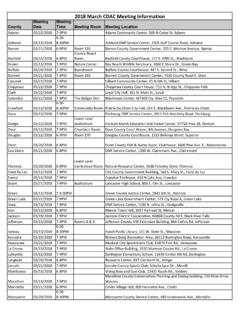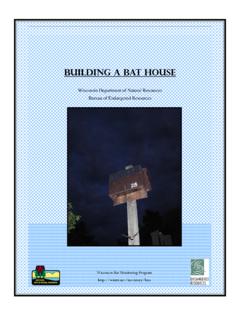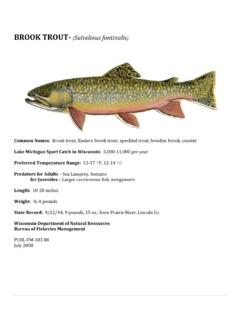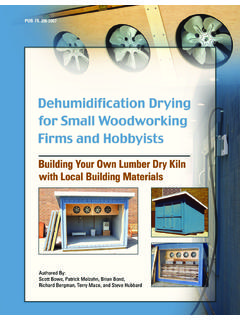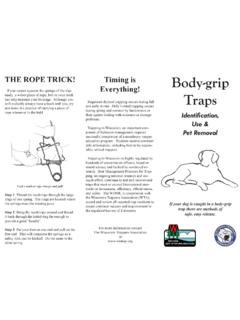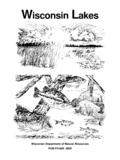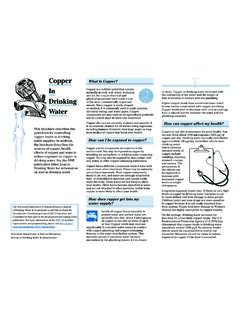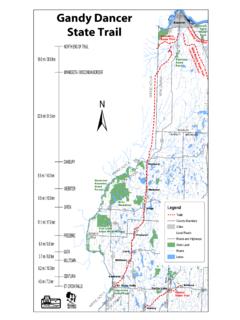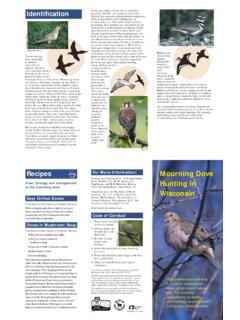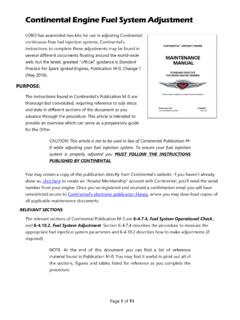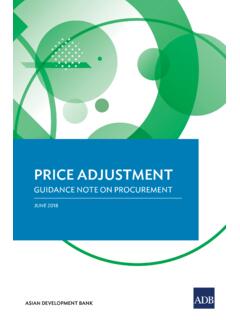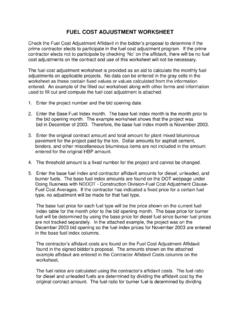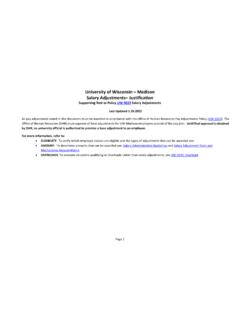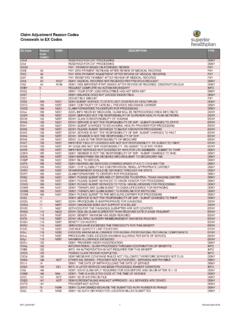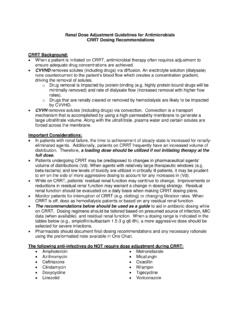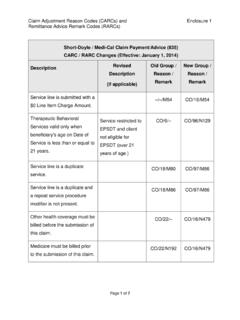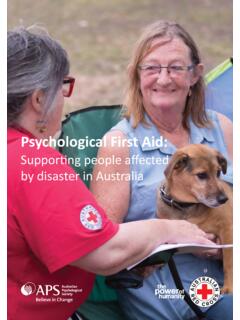Transcription of Zoning Board Handbook - Wisconsin Department of Natural ...
1 For Wisconsin Zoning Boards of adjustment and AppealsLynn MarkhamandRebecca RobertsCenter for Land Use EducationZoning Board Handbook2nd Edition2006 iZONING Board HANDBOOKFor Wisconsin Zoning Boards of adjustment and Appeals2nd Edition 2006 Lynn Markham and Rebecca RobertsCover photos: Top: Potential land use confl ict between gravel pit and adjacent housing. Photo Regents of the University of Minnesota. Used with the permission of Metropolitan Design Center. Center: Waterfront home in Oneida County lacking shoreland buffer. Photo courtesy of Robert Korth, UW-Extension Lakes Partnership. Bottom: Potential land use confl ict between industrial and residential land uses. Photo Regents of the University of Minnesota. Used with the permission of Metropolitan Design gratefully acknowledge the funding provided for this undertaking by the Wisconsin Department of Natural Resources and the University of Wisconsin Extension. We would also like to thank Robert Newby at the Center for Land Use Education for coordinating the layout and design of this is the second edition of the Zoning Board Handbook .
2 The fi rst edition by Michael D. Dresen and Lynn Markham was published in 2001. Both editions are based on educational materials developed by James H. Schneider, Attorney and Local Government Specialist at the UW-Extension Local Government would also like to acknowledge those individuals that have reviewed portions of the text or provided examples including Fred Anderson; Jeff Bluske, La Crosse County Zoning and Land Information Department ; Dan Bowers, Lincoln County Planning and Zoning Department ; Gregg Breese, Wisconsin Department of Natural Resources; Andy Buehler, Kenosha County Department of Planning and Development; James Burgener, Marathon County Conservation, Planning and Zoning Department ; Earl Cook; Mike Dresen; JoAnne Kloppenberg, Wisconsin Department of Justice; Pam LaBine, Forest County Zoning Department ; Brian Ohm, Department of Urban and Regional Planning, UW-Madison/UW-Extension; Marcia Penner, Wisconsin Department of Natural Resources; Dean Richards, Waukesha offi ce of Reinhart Boerner Van Deuren.
3 Michelle Staff, Jefferson County Zoning , Sanitation and Solid Waste Department ; and Tom Steidl, Wisconsin Department of Natural Resources. While we are grateful for their suggestions and comments, any errors in this edition are the full responsibility of the THE AUTHORSLynn Markham is a Land Use Specialist with UW-Extension at the Center for Land Use Education at the University of Wisconsin Stevens Point. She provides workshops for Zoning Board members. In addition, she assists communities who want to protect their drinking water, lakes and streams by providing them with research-based information and policy options. She received a Bachelor of Science degree in chemistry from Ripon College and a Master of Science degree in biochemistry from the University of Oregon. She is co-author of Zoning Nonconformities and Protecting Your Waterfront Investment: 10 Simple Shoreland Stewardship Steps. Rebecca Roberts is a Land Use Specialist with UW-Extension at the Center for Land Use Education at the University of Wisconsin Stevens Point.
4 In partnership with local educators, she provides workshops for Zoning Board members, plan commissioners and other local government offi cials. In addition, she assists communities with comprehensive planning, public participation and the fi scal impacts of land use decisions. She received a Bachelor of Arts in biology and environmental studies from Augustana College and a Master of Urban Planning from the University of Illinois. She is managing editor of the Land Use Tracker newsletter and a contributing author to the Land Use Resource Guide and Land Use Megatrends of ContentsAcknowledgements iiAbout The Authors iiIntroduction 1 Section I: Zoning Board BasicsSection I: Zoning Board BasicsChapter 1: Introduction to Zoning 5 Elements of a Zoning Ordinance 6 Allowable Uses for each District 7 Relief from Strict Adherence to the Zoning Code 8 Map and Text Amendments 8 Additional Forms of Zoning 8 Zoning and the Comprehensive Plan 9 Chapter 2: Introduction to the Zoning Board 11 Role of the Zoning Board 11 Zoning Board Authority 12 Chapter 3: Formation and Organization of the Zoning Board 15 Considerations for Appointment 17 Appointment of Alternates 17ivTable of ContentsFilling Vacancies 18 Removal for Cause 18 Selection and Duties of Zoning Board Offi cers 18 Section I Review 21 Section II: Laws that Apply to the Zoning BoardSection II.
5 Laws that Apply to the Zoning BoardChapter 4: Overview of Laws that Apply to the Zoning Board 23 Chapter 5: Open Meetings Law 25 Open Meetings 25 Closed Sessions 26 Public Notifi cation 28 Public Notifi cation of Hearings 30 Violations of the Open Meetings Law 34 Chapter 6: Ethical and Procedural Considerations 37 Zoning Boards Must Follow the Rules of Due Process 37 Zoning Board Members Must Be Impartial 38If You Are Not Impartial, Recuse Yourself 39 Avoid Ex Parte Communication 40 Provide an Opportunity to Present at Hearings 40 Avoid Statutory Confl icts of Interest 41 Chapter 7: Adoption of Operating Rules 43 Content of Operating Rules 44 Section II Review 47 Section III: Zoning Board Decision ProcessSection III: Zoning Board Decision ProcessChapter 8: Application Process 51 Who completes the application to the Zoning Board ? 52 When do applications need to be complete? Can subsequent changes be made? 52 What is included in a complete application?
6 53 Who reviews the applications? 56 Are Zoning staff reports recommended and what do they contain? 56 Chapter 9: Site Visits 59 What equipment is needed for a site inspection? 60 Must Zoning boards comply with the open meetings law during site inspections? 60vTable of ContentsWho may access a property for a site inspection? 60 Chapter 10: Meetings and Hearings 61 Zoning Board Hearing Checklist 62 Zoning Board Announcement Of Proceedings 63 Chapter 11: Voting and Recording Decisions 65 How does the Zoning Board reach a decision? 65To what extent must Zoning Board members explain their reasoning for approving or denying an application? 66 How many Zoning Board members must vote to make a decision? 67 Should a Zoning Board rehear or reconsider their decisions? 68 What information needs to be in the record? 68 How long must records of the Zoning Board be kept? 69 Who enforces the decisions of the Zoning Board ? 69If the Supreme Court changes a legal decision standard after a Zoning Board decides a case and before that case is remanded back to the Zoning Board , what decision standard should the Board use when reevaluating the case?
7 69 Section III Review 71 Section IV: Decisions of the Zoning BoardSection IV: Decisions of the Zoning BoardChapter 12: Discretion Associated with Zoning Decisions 73 Chapter 13: Administrative Appeals 77 What is the process for fi ling an administrative appeal? 79 How are disputes regarding ordinance interpretations resolved? 80 How are disputes regarding boundary interpretations resolved? 83 May a Zoning Board decision of an administrative appeal be appealed to circuit court? 83 Chapter 14: Conditional Uses and Special Exceptions 85 What is a conditional use? 85 How are conditional uses decided? 86 Who decides whether to grant conditional uses? 86 What conditions may be attached to a conditional use permit? 87 Who decides appeals of conditional use decisions? 89 What standards apply when the Zoning Board hears an appeal of a conditional use decision? 90 May a conditional use decision by the Zoning Board or governing body be appealed to circuit court?
8 91viChapter 15: Variances 93 What are the criteria for granting a variance? 94 Are multiple variances allowed? 100 What is the process for appealing a variance decision? 101 Why are the standards for area variances different from those of use variances? 101 Area Variances And Use Variances 102 Chapter 16: Accomodations for the Disabled 103 What is a reasonable accommodation ? 104 What is the recommended approach for providing reasonable accommodations? 104 May local governments impose conditions on accommodations for the disabled? 106 Section IV Review 107 Section V: Appeal of Zoning Board DecisionsSection V: Appeal of Zoning Board DecisionsChapter 17: Appeal of Zoning Board Decisions 111 What is an appeal? 111 Who may appeal Zoning Board decisions? 112 How long does a person have to appeal a Zoning Board decision? 112 What must be done within the 30 day time period to appeal a Zoning Board decision? 113If a certiorari lawsuit is fi led, what is the Zoning Board required to do?
9 113 When a Zoning Board decision is pending before the circuit court, what may the Zoning administrator and Zoning Board do? 113 What happens to the construction project if the Zoning Board decision is appealed? 114 What decisions may a circuit court make on appeal? 114 May the circuit court take additional evidence? 115If the circuit court does not take additional evidence, what standards does the court use in reviewing Zoning Board decisions? 116 Can Zoning Board decisions be appealed beyond circuit court? 118 Section V Review 119 Section VI: Improving Zoning Board DecisionsSection VI: Improving Zoning Board DecisionsChapter 18: Understanding Who the Zoning Board Works With 121 Planning and Zoning Staff 122 Planning and Zoning Committee/Commission 122 Governing Body (County Board , Town Board , Village Board , City Council) 123 Local Residents 124 Developers, Realtors, Builders, and Other Contractors 125 Attorneys 125viiTable of ContentsNews Reporters 125UW-Extension Educators 126 Chapter 19.
10 Conducting an Annual Self-Audit 127 Review Zoning Board Decisions 127 Communicate with Plan Committee/Commission 128 Review Informational Materials and Forms 128 Review, Enforcement, and Appeals Procedures 129 Review Rules for Conduct of Meetings and Hearings 130 Review Need for Counsel 130 Take Advantage of Opportunities for Continuing Education 131 Chapter 20: Translating Zoning Board Decisions into Better Zoning Ordinances 133 How can the Zoning Board and plan committee/commission work together to improve the local Zoning ordinance? 134 Section VI Review 135 Section VII: Shoreland and Floodplain ZoningSection VII: Shoreland and Floodplain ZoningChapter 21: Shoreland Zoning 139 Where does shoreland Zoning apply? 139 Purposes of shoreland Zoning 140 How do our shoreland decisions affect property values, water quality, fi sheries and wildlife? 140 Minimum statewide shoreland Zoning standards 146 For more information about how shoreland management affects lakes and streams, read 148 Chapter 22: Floodplain Zoning 149 Where does fl oodplain Zoning apply?

